Home gardening is a popular and easy way to get fresh, organic vegetables and connect them to nature. Growing vegetables at home allows individuals to control what they eat, ensuring it is free from harmful chemicals.
Potatoes are one of the best crops to grow at home. They are simple to cultivate, even for beginners, and provide a generous harvest. In the kitchen, potatoes are incredibly versatile, perfect for making dishes like crispy fries or creamy mashed potatoes. They also store well so that homegrown potatoes can last for months after harvesting.
Growcycle provides gardening products like seeds, soil, pots, and grow lights to help people grow their own food. For potatoes, they offer potato seeds, quality soil, and containers to create the perfect growing setup. Thus, Growcycle makes it easier for anyone to grow potatoes at home.
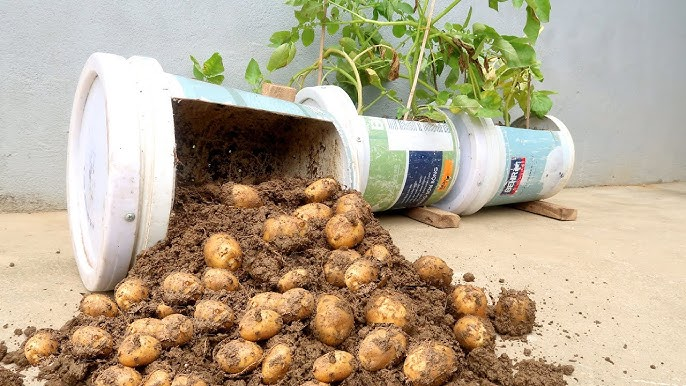
Botanical Description
The potato (Solanum tuberosum) is a starchy, tuberous crop belonging to the family Solanaceae, commonly known as the nightshade family. It is an herbaceous perennial plant native to the Andes region of South America, but it is now cultivated worldwide as a staple food crop.
- Roots: Potatoes have a fibrous root system that anchors the plant and absorbs water and nutrients. The storage organs, or tubers, form underground as modified stems.
- Stems: The plant has green, herbaceous stems that grow above the ground and can reach heights of 12–40 inches. Stolons, or underground horizontal stems, extend from the main stem and give rise to tubers.
- Leaves: Potato leaves are compound, consisting of 7–9 leaflets. The leaflets are dark green, oval, and have a slightly wavy margin.
- Flowers: Potato flowers are typically white, purple, or pink, with a yellow central cone formed by fused stamens. They are borne in clusters called inflorescences on the above-ground stems.
- Fruits: The fruit is a small, green, spherical berry containing numerous seeds. It is toxic due to high levels of solanine, a natural alkaloid.
- Tubers: The tubers are the edible part of the plant, forming at the tips of stolons. They are round, oval, or oblong and come in various skin colors (white, brown, red, purple) and flesh colors (white, yellow, or purple). The tubers store starch and serve as the plant's energy reserves.
Characteristics of Potatoes
Potatoes (Solanum tuberosum) exhibit various physical traits depending on the variety and growing conditions. These characteristics make them versatile for culinary use and suitable for different climates and soils.
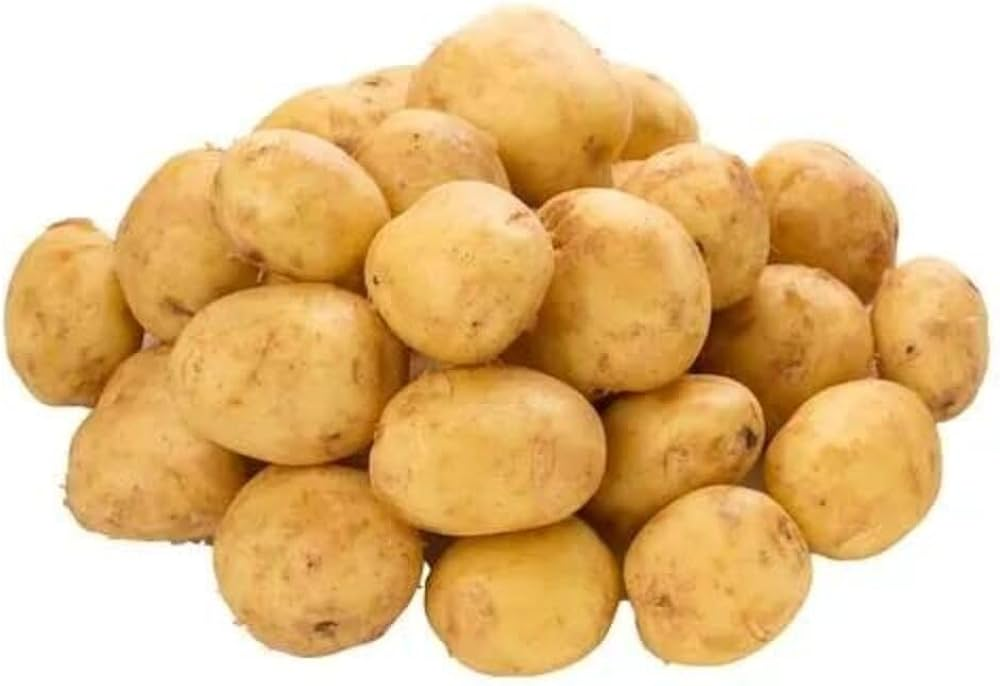
1. Shape
Potatoes come in various shapes, including:
- Round: Perfectly spherical or nearly so (e.g., Red Norland).
- Oval: Egg-shaped or elongated oval (e.g., Yukon Gold).
- Oblong: Long and cylindrical, sometimes slightly flattened (e.g., Russet Burbank).
- Fingerling: Small, narrow, and cylindrical, resembling fingers (e.g., French Fingerling).
2. Size
Potatoes vary significantly in size, ranging from small baby potatoes to large baking varieties.
- Small: Typically 2–4 cm in diameter, often harvested early or marketed as "baby potatoes."
- Medium: About 5–7 cm, commonly used for boiling, mashing, or roasting.
- Large: Over 8 cm, ideal for baking or frying (e.g., Russet varieties).
3. Skin Color
Potato skin color can vary widely and includes:
- White/Cream: Common in traditional table potatoes.
- Brown/Russet: Rough-textured, ideal for baking and frying.
- Red: Smooth, thin skin often used for salads (e.g., Red Pontiac).
- Purple/Blue: Deep, vibrant colors rich in antioxidants (e.g., Purple Majesty).
- Yellow: Golden skin, commonly found in buttery, waxy potatoes (e.g., Yukon Gold).
4. Flesh Color
The flesh inside potatoes also varies:
- White/Cream: The most common is mild flavor (e.g., Kennebec).
- Yellow: Creamy and rich in flavor (e.g., Yukon Gold).
- Red/Pink: Rare but adds a unique aesthetic (e.g., Highland Burgundy Red).
- Purple/Blue: Vibrant, nutrient-rich, and visually striking (e.g., All Blue).
5. Texture
Potatoes are often classified by their texture, which determines their cooking use:
- Starchy: These have high starch and low moisture. They are fluffy when cooked and are best for baking, mashing, and frying (e.g., Russet).
- Waxy: It is low in starch and high in moisture. When cooked, it is firm, making it ideal for boiling and salads (e.g., Red Bliss).
- All-Purpose: Moderate starch content; versatile for most cooking methods (e.g., Yukon Gold).
6. Size and Number of Eyes
Potatoes have "eyes" or buds, which sprout when planted.
- Shallow Eyes: Easier to peel and process.
- Deep Eyes: Common in certain varieties, slightly more labor-intensive to peel.
Types of Potatoes
Potatoes are incredibly diverse, with hundreds of varieties grown worldwide. They are often categorized based on their texture, shape, color, and culinary use. Here are the main types of potatoes:
| Type | Shape & Skin | Flesh | Texture | Best Uses |
| Russet | Oblong, rough brown skin | White | Starchy, fluffy | Baking, frying (e.g., French fries), mashing |
| Red | Round, smooth red skin | White or yellow | Waxy, firm | Boiling, roasting, potato salads |
| Yukon Gold | Round, golden skin | Yellow | All-purpose, creamy | Mashing, roasting, soups, baking |
| Fingerling | Small, narrow, elongated | Yellow or red | Waxy, firm | Roasting, pan-frying, salads |
| White | Round or oval, smooth, thin white skin | White | All-purpose, moist | Boiling, mashing, steaming, salads |
| Purple/Blue | Round or oval, dark purple or blue skin | Purple or blue | Waxy, firm | Roasting, baking, chips, salads |
| Petite (Baby) | Small, any skin color | Varies | Firm or waxy | Roasting, steaming, side dishes |
How to Grow Potatoes at Home
Growing potatoes at home doesn’t require much space or special skills. Anyone can grow potatoes with a few easy steps, whether they have a backyard garden, a small balcony, or just a few containers.
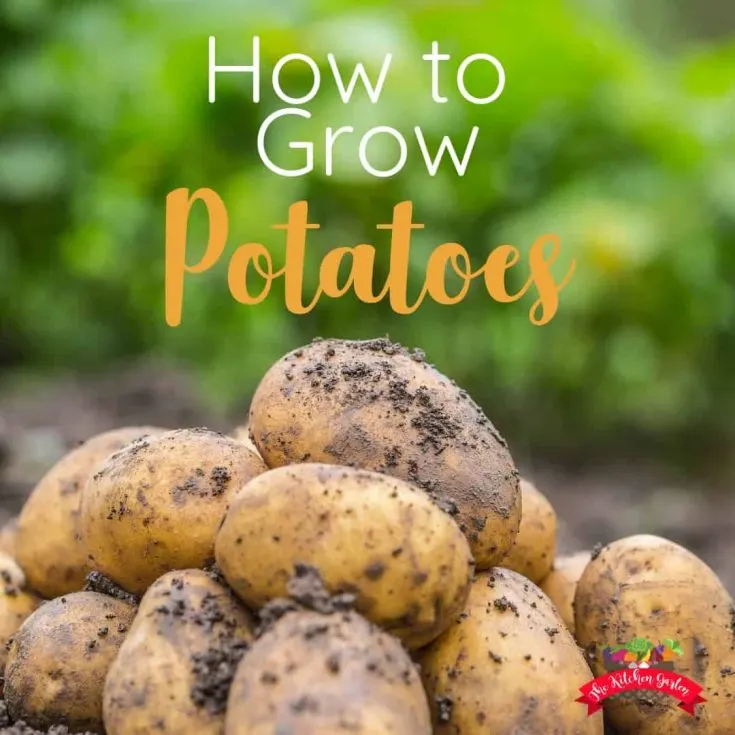
1. Choose the Right Location
Potatoes need 6–8 hours of sunlight daily to grow well. Sunlight helps the plant to produce energy through photosynthesis, which is essential for strong growth and healthy potatoes. Without enough sunlight, the plants may grow weak and give small yields.
2. Prepare the Soil
Before planting, test the pH of the soil. Growers can use a pH tester or send a soil sample to a local service. Potatoes grow best in slightly acidic soil, with a pH between 5.0–7.0. If the soil is too acidic, add lime to raise the pH. If the soil is too alkaline, add sulfur to lower the pH.
Potatoes need rich, well-draining soil. Organic matter, such as compost, rotted manure, or peat moss, can improve the soil's drainage and help it retain moisture.
3. Selecting Seed Potatoes
Always use seed potatoes instead of regular grocery store potatoes. Seed potatoes are specially grown for planting and are disease-free. Grocery potatoes may be treated with chemicals to prevent sprouting, which can harm the crop.
4. Pre-sprouting Seed Potatoes (Chitting)
Chitting is the process of encouraging seed potatoes to sprout before planting. This step isn’t necessary, but it helps the potatoes to grow faster, especially in areas with short growing seasons. Place seed potatoes in a cool, bright spot (about 50°F) for 2–4 weeks before planting.
- Lay the potatoes on their sides with the "eyes" (buds) facing up.
- The potatoes will grow short, sturdy sprouts. The seed potatoes are ready for planting when the sprouts are about 1 inch long.
5. Planting Potatoes
The best time to plant potatoes depends on the local climate. Plant 2–4 weeks before the last frost date in the area. In cooler regions, plant in early spring; in warmer regions, plant in late winter or early spring. The soil temperature should be at least 45–50°F for optimal growth.
6. Planting Methods
- In traditional garden beds, plant potatoes directly in the soil. Space the rows about 30–36 inches apart, and plant the seed potatoes about 12 inches apart in each row.
- Raised beds are great for areas with poor soil or limited space. They improve drainage and are easy to manage. Before preparing the raised beds, ensure the soil is deep enough for potatoes to grow well.
- If growers have limited space or poor soil, they can grow potatoes in containers or grow bags. Use containers that are at least 18 inches deep and have drainage holes. Fill the container with loose, well-draining soil and plant the seed potatoes in layers, adding more soil as the plants grow. This method is perfect for small gardens or balconies.
Potato Care During Growth
Taking care of potatoes as they grow is important for getting a good harvest. Here is what to do to help the plants grow strong and healthy:
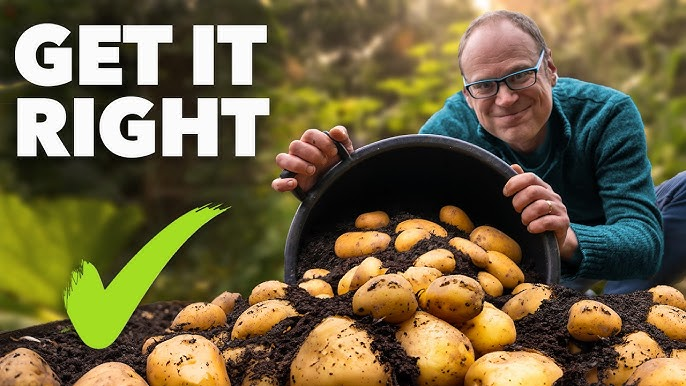
1. Watering
Potatoes need regular watering to grow well, especially when the tubers (potatoes) are forming. It’s best to water them with about 1–2 inches of water each week. During hot or dry weather, they may need more water.
- Overwatering: If the plants get too much water, their leaves will turn yellow, and the soil will feel soggy. This can cause root rot.
- Underwatering: If the leaves start wilting, turning brown, or curling, the plants are not getting enough water. Keep the soil moist, especially when the potatoes are forming.
2. Fertilizing
Potatoes need a lot of nutrients, so to support strong growth, they should be fertilized with a balanced fertilizer (5-10-10 NPK) that is low in nitrogen and high in phosphorus and potassium. Gardeners can also use organic options like compost.
- Early Growth: Fertilize the soil when the potato plants are small, about 2 weeks after planting. This helps the plants grow strong roots.
- Flowering Stage: Apply fertilizer again when the plants start to flower. This helps the potatoes grow well.
3. Hilling
Hilling means mounding soil around the base of the plants. This helps in many ways:
- It keeps the potatoes covered and prevents them from turning green and becoming inedible.
- It helps the plant grow more potatoes.
- It supports the plant as it grows taller.
To Hill the Potatoes, follow these tips:
- Once the plants are about 6–8 inches tall, use a shovel to mound soil around the base of each plant.
- Keep adding soil around the plant as it grows taller until it’s about 12 inches high.
4. Pests and Diseases
- Colorado Potato Beetle: This beetle eats the leaves of the plants. How to control it: Pick the beetles off by hand, use organic insecticidal soap, or attract ladybugs to eat the beetles.
- Aphids: Small insects that suck the sap from the leaves. How to control them: Use neem oil or insecticidal soap to get rid of aphids. Ladybugs can also help by eating aphids.
- Flea Beetles: Small beetles that make tiny holes in the leaves. How to control them: Protect young plants with row covers or use diatomaceous earth around them.
- Early Blight: A disease that causes dark spots on leaves. To prevent it, Change the location of the plant each year, water at the soil level, and use fungicides if necessary.
- Late Blight: A severe disease that makes the plants wilt and develop mold. To prevent it, remove infected leaves, use resistant potato varieties, and use water early in the day to reduce moisture.
Harvesting Potatoes
Potatoes are ready to harvest when the tops of the plants start to yellow and die back. This usually happens about 2-4 weeks after flowering. The leaves will begin to wilt, and the plant will stop growing. Growers can also check by gently digging around the base of the plant to see if the potatoes are fully formed.
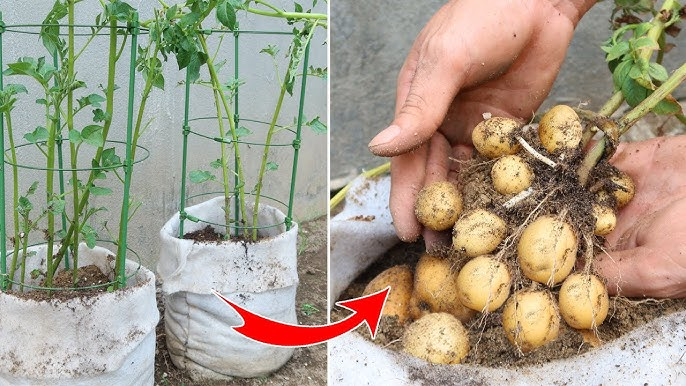
Early vs. Late Harvests
- Early Harvest: If growers want new potatoes, they can harvest them early, usually about 8-10 weeks after planting. These small and tender potatoes are perfect for eating right away.
- Late Harvest: For fully grown, mature potatoes, wait until the plant’s leaves are completely dead. This usually happens around 12-16 weeks after planting. The longer the potatoes are left to grow, the larger they will be, but they may also have thicker skins.
Step-by-Step Harvesting Process
- Stop watering the plants a few days before harvesting to allow the soil to dry. This will make digging easier and help the potatoes develop thicker skins.
- Use a spade or garden fork to dig around the base of the plant, being careful not to damage the potatoes. Start digging about 12 inches away from the stem to avoid hitting the tubers.
- Once the plant is lifted, carefully pull the potatoes from the soil. If the soil is loose, the potatoes should come up easily.
- Sort through the harvest and set aside any damaged or bruised potatoes. These should be used first, as they don’t store well.
- Gently brush off the dirt from the potatoes. Don’t wash them with water yet, as excess moisture can cause them to rot. Let the potatoes dry for a few hours in a cool, dry place.
- Once dry, store the potatoes in a cool, dark place. Ideal storage conditions are 45–50°F (7–10°C) with high humidity. Avoid storing them in direct sunlight, as it can cause the potatoes to turn green and become toxic.
Uses of Potatoes
Potatoes are incredibly versatile and can be used in a wide variety of ways, both in cooking and other applications. Here are some common uses of potatoes:
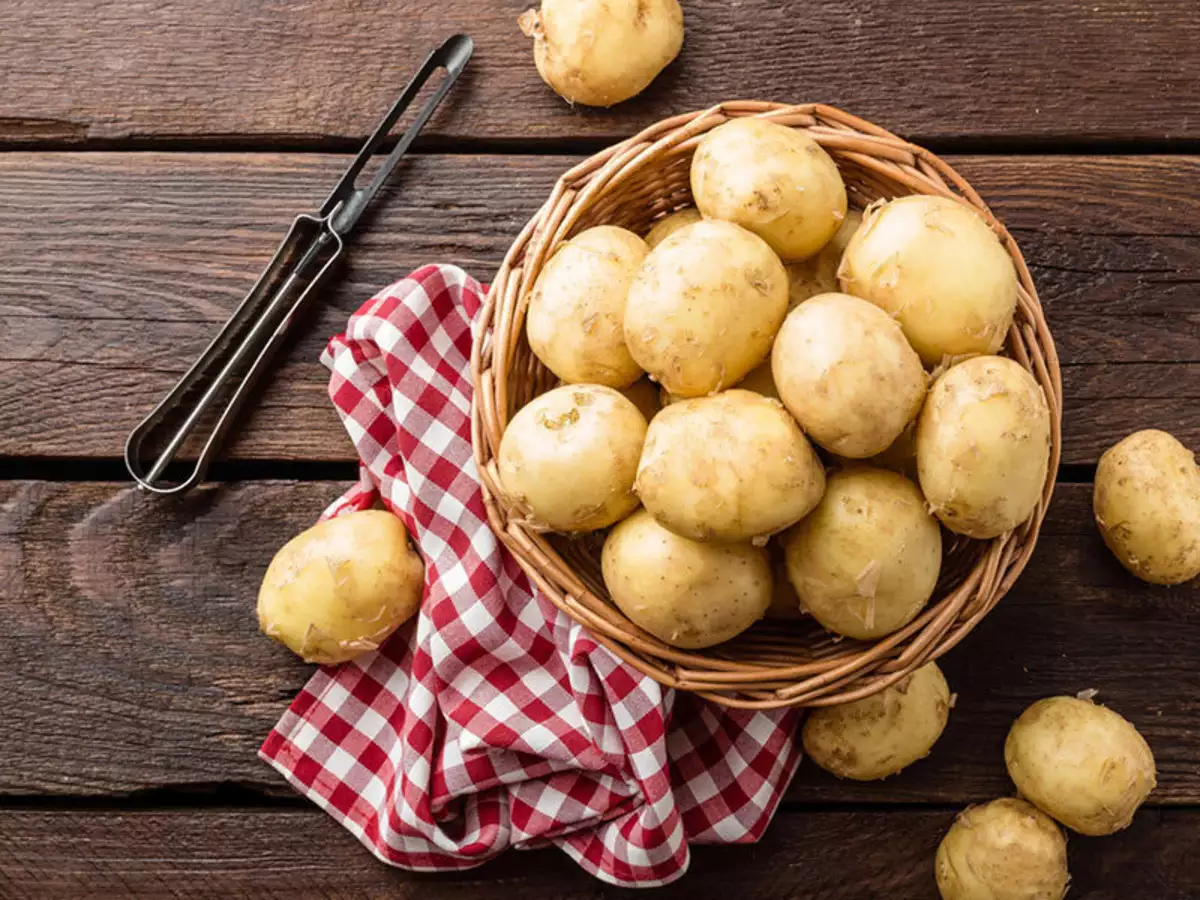
- Mashed Potatoes are a classic side dish made by boiling potatoes and mashing them with butter, cream, and seasonings.
- Baked Potatoes: Potatoes can be baked whole in their skins, often served with toppings like sour cream, cheese, and chives.
- French Fries are a popular snack or side dish made by cutting potatoes into strips and deep-frying them to create crispy, golden fries.
- Roasted Potatoes: These are a crispy, flavorful side dish made from chunks of potatoes that are seasoned and roasted in the oven.
- Potato Salad: Cooked potatoes are mixed with mayonnaise, mustard, herbs, and other ingredients to create a refreshing salad.
- Potato Soup: Potatoes can be used to make creamy soups, often combined with vegetables, broth, and seasonings.
- Chips: Thin slices of potatoes are fried or baked to make crispy potato chips, a favorite snack.
- Gratin or Dauphinoise Potatoes: Thinly sliced potatoes are layered with cream, cheese, and herbs, then baked until golden and bubbly.
- Potato Gnocchi: A type of Italian dumpling made from mashed potatoes, flour, and eggs, often served with sauce.
- Potato Starch: The starch extracted from potatoes is used in food processing and baking and as a thickening agent for sauces and soups.
- Potato Flour: Made by grinding dried potatoes, it is used in gluten-free baking and as a thickener.
- Animal Feed: Potatoes that are not suitable for human consumption can be used as livestock feed.
- Cosmetic Products: Potato juice and extracts are sometimes used in skincare products for their purported benefits, such as reducing dark spots or soothing irritated skin.
- Biofuels: Potato waste can be processed into biofuels, offering an environmentally friendly alternative energy source.
- Potato Sprouts: The eyes (buds) of the potato can be used as seed potatoes to grow new plants.
FAQs
What are the easiest potatoes to grow at home?
Early varieties like Yukon Gold and Red Pontiac are the easiest potatoes to grow at home. These types are hardy, grow well in various conditions, and require minimal care.
When is the best time to plant potatoes?
Potatoes grow best in cool weather. Plant them in early spring after the last frost or in late summer for a fall harvest, depending on the location.
What is the best fertilizer for potatoes?
A balanced fertilizer, such as 05-10-10 (NPK), works well for potatoes. Growers can also use organic fertilizers, such as compost or well-rotted manure, to promote healthy growth and good yields.
The Bottom Line
Growing potatoes at home is an easy way to get fresh, healthy food straight from the garden. Anyone can grow potatoes in their backyard, containers, or small spaces with little care. Potatoes are great in many dishes and can be stored for months, making them a useful crop for home gardeners.
Using quality products from marketplaces like Growcycle can make growing potatoes even easier. Whether someone is new to gardening or has experience, growing their own potatoes brings a sense of achievement and a healthy diet.
Disclaimer: This material is for informational purposes only and should not be relied on for legal, medical, financial, or any other form of professional advice.
About the Author
Environmental Journalist Focused on Sustainable Agriculture
Victor Miller is an environmental journalist at Growcycle, specializing in sustainable agriculture. With a passion for storytelling, he highlights the latest trends, innovations, and practices that promote ecological balance and responsible farming.

